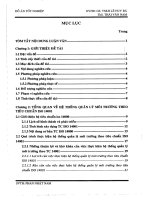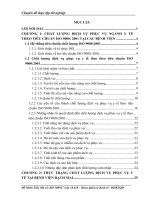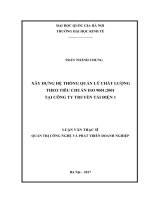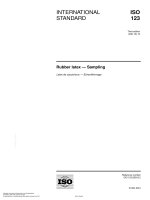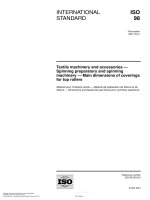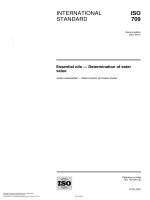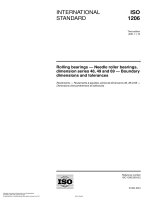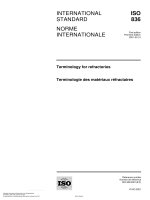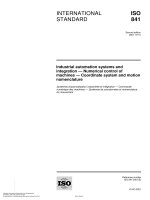Tiêu chuẩn iso 15161 2001
Bạn đang xem bản rút gọn của tài liệu. Xem và tải ngay bản đầy đủ của tài liệu tại đây (1.19 MB, 44 trang )
INTERNATIONAL
STANDARD
ISO
15161
First edition
2001-11-15
Guidelines on the application of
ISO 9001:2000 for the food and drink
industry
Lignes directrices relatives à l'application de l'ISO 9001:2000 aux industries
de l'alimentaire et des boissons
Reference number
ISO 15161:2001(E)
© ISO 2001
ISO 15161:2001(E)
PDF disclaimer
This PDF file may contain embedded typefaces. In accordance with Adobe's licensing policy, this file may be printed or viewed but shall not
be edited unless the typefaces which are embedded are licensed to and installed on the computer performing the editing. In downloading this
file, parties accept therein the responsibility of not infringing Adobe's licensing policy. The ISO Central Secretariat accepts no liability in this
area.
Adobe is a trademark of Adobe Systems Incorporated.
Details of the software products used to create this PDF file can be found in the General Info relative to the file; the PDF-creation parameters
were optimized for printing. Every care has been taken to ensure that the file is suitable for use by ISO member bodies. In the unlikely event
that a problem relating to it is found, please inform the Central Secretariat at the address given below.
© ISO 2001
All rights reserved. Unless otherwise specified, no part of this publication may be reproduced or utilized in any form or by any means, electronic
or mechanical, including photocopying and microfilm, without permission in writing from either ISO at the address below or ISO's member body
in the country of the requester.
ISO copyright office
Case postale 56 • CH-1211 Geneva 20
Tel. + 41 22 749 01 11
Fax + 41 22 749 09 47
Web www.iso.ch
Printed in Switzerland
ii
© ISO 2001 – All rights reserved
ISO 15161:2001(E)
Contents
Page
Foreword.....................................................................................................................................................................iv
Introduction .................................................................................................................................................................v
1
Scope .............................................................................................................................................................. 1
2
Normative reference ...................................................................................................................................... 1
3
Terms and definitions ................................................................................................................................... 1
4
4.1
4.2
Quality management system........................................................................................................................ 3
General requirements.................................................................................................................................... 3
Documentation requirements....................................................................................................................... 4
5
5.1
5.2
5.3
5.4
5.5
5.6
Management responsibility .......................................................................................................................... 7
Management commitment ............................................................................................................................ 7
Customer focus ............................................................................................................................................. 7
Quality policy ................................................................................................................................................. 8
Planning.......................................................................................................................................................... 8
Responsibility, authority and communication ........................................................................................... 9
Management review..................................................................................................................................... 10
6
6.1
6.2
6.3
6.4
Resource management ............................................................................................................................... 11
Provision of resources................................................................................................................................ 11
Human resources ........................................................................................................................................ 11
Infrastructure ............................................................................................................................................... 12
Work environment ....................................................................................................................................... 12
7
7.1
7.2
7.3
7.4
7.5
7.6
Product realization ...................................................................................................................................... 13
Planning of product realization.................................................................................................................. 13
Customer-related processes ...................................................................................................................... 15
Design and development ............................................................................................................................ 17
Purchasing ................................................................................................................................................... 20
Production and service provision.............................................................................................................. 22
Control of monitoring and measuring devices......................................................................................... 25
8
8.1
8.2
8.3
8.4
8.5
Measurement, analysis and improvement ................................................................................................ 26
General.......................................................................................................................................................... 26
Monitoring and measurement .................................................................................................................... 27
Control of nonconforming product............................................................................................................ 29
Analysis of data ........................................................................................................................................... 30
Improvement ................................................................................................................................................ 30
Annex A (informative) Interrelationship between the HACCP and ISO 9001:2000 systems ............................. 33
Bibliography .............................................................................................................................................................. 35
© ISO 2001 – All rights reserved
iii
ISO 15161:2001(E)
Foreword
ISO (the International Organization for Standardization) is a worldwide federation of national standards bodies (ISO
member bodies). The work of preparing International Standards is normally carried out through ISO technical
committees. Each member body interested in a subject for which a technical committee has been established has
the right to be represented on that committee. International organizations, governmental and non-governmental, in
liaison with ISO, also take part in the work. ISO collaborates closely with the International Electrotechnical
Commission (IEC) on all matters of electrotechnical standardization.
International Standards are drafted in accordance with the rules given in the ISO/IEC Directives, Part 3.
Draft International Standards adopted by the technical committees are circulated to the member bodies for voting.
Publication as an International Standard requires approval by at least 75 % of the member bodies casting a vote.
Attention is drawn to the possibility that some of the elements of this International Standard may be the subject of
patent rights. ISO shall not be held responsible for identifying any or all such patent rights.
International Standard ISO 15161 was prepared by Technical Committee ISO/TC 34, Food products.
Annex A of this International Standard is for information only.
A list of standards and other publications related to this International Standard is given in the Bibliography.
iv
© ISO 2001 – All rights reserved
ISO 15161:2001(E)
Introduction
ISO 9001:2000, Quality management systems — Requirements
0.1 General
The adoption of a quality management system should be a strategic decision of an organization. The design and
implementation of an organization's quality management system is influenced by varying needs, particular
objectives, the products provided, the processes employed and the size and structure of the organization. It is not
the intent of this International Standard to imply uniformity in the structure of quality management systems or
uniformity of documentation.
The quality management system requirements specified in this International Standard are complementary to
requirements for products. Information marked “NOTE” is for guidance in understanding or clarifying the associated
requirement.
This International Standard can be used by internal and external parties, including certification bodies, to assess
the organization’s ability to meet customer, regulatory and the organization's own requirements.
The quality management principles stated in ISO 9004:2000 have been taken into consideration during the
development of this International Standard.
0.2 Process approach
This International Standard promotes the adoption of a process approach when developing, implementing and
improving the effectiveness of a quality management system, to enhance customer satisfaction by meeting
customer requirements.
For an organization to function effectively, it has to identify and manage numerous linked activities. An activity
using resources, and managed in order to enable the transformation of inputs into outputs, can be considered as a
process. Often the output from one process directly forms the input to the next.
The application of a system of processes within an organization, together with the identification and interactions of
these processes, and their management, can be referred to as the “process approach”.
An advantage of the process approach is the ongoing control that it provides over the linkage between the
individual processes within the system of processes, as well as over their combination and interaction.
When used within a quality management system, such an approach emphasizes the importance of
a) understanding and fulfilling requirements,
b) the need to consider processes in terms of added value,
c) obtaining results of process performance and effectiveness, and
d) continual improvement of processes based on objective measurement.
The model of a process-based quality management system shown in Figure 1 illustrates the process linkages
presented in clauses 4 to 8. This illustration shows that customers play a significant role in defining requirements as
inputs. Monitoring of customer satisfaction requires the evaluation of information relating to customer perception as
to whether the organization has met the customer requirements. The model shown in Figure 1 covers all the
requirements of this International Standard, but does not show processes at a detailed level.
© ISO 2001 – All rights reserved
v
ISO 15161:2001(E)
NOTE
In addition, the methodology known as “Plan-Do-Check-Act” (PDCA) can be applied to all processes. PDCA can be
briefly described as follows:
Plan:
establish the objectives and processes necessary to deliver results in accordance with customer requirements
and the organization's policies.
Do:
implement the processes.
Check:
monitor and measure processes and product against policies, objectives and requirements for the product and
report the results.
Act:
take actions to continually improve process performance.
Figure 1 — Model of a process-based quality management system
0.3 Relationship with ISO 9004
The present editions of ISO 9001 and ISO 9004 have been developed as a consistent pair of quality management
system standards which have been designed to complement each other, but can also be used independently.
Although the two International Standards have different scopes, they have similar structures in order to assist their
application as a consistent pair.
ISO 9001 specifies requirements for a quality management system that can be used for internal application by
organizations, or for certification, or for contractual purposes. It focuses on the effectiveness of the quality
management system in meeting customer requirements.
vi
© ISO 2001 – All rights reserved
ISO 15161:2001(E)
ISO 9004 gives guidance on a wider range of objectives of a quality management system than does ISO 9001,
particularly for the continual improvement of an organization’s overall performance and efficiency, as well as its
effectiveness. ISO 9004 is recommended as a guide for organizations whose top management wishes to move
beyond the requirements of ISO 9001, in pursuit of continual improvement of performance. However, it is not
intended for certification or for contractual purposes.
0.4 Compatibility with other management systems
This International Standard has been aligned with ISO 14001:1996 in order to enhance the compatibility of the two
standards for the benefit of the user community.
This International Standard does not include requirements specific to other management systems, such as those
particular to environmental management, occupational health and safety management, financial management or
risk management. However, this International Standard enables an organization to align or integrate its own quality
management system with related management system requirements. It is possible for an organization to adapt its
existing management system(s) in order to establish a quality management system that complies with the
requirements of this International Standard.
There is a need for guidance on implementing the requirements of ISO 9001 for organizations involved in all
aspects of the food and drink industry. This includes organizations involved in sourcing, processing and packaging
food and drink products. This International Standard aims to encourage the use of the ISO 9000 series of
standards within the food and drink industry – the use of these standards alongside other common systems in use
in this sector may assist an organization to better address customer satisfaction and organizational effectiveness
by the effective implementation of a quality management system.
ISO 9001 also requires organizations to seek to continually improve their quality management systems, an aspect
often missing from other models of food safety management commonly used in the food and drink industry.
The adoption of a quality management system needs to be a strategic decision of the organization. The design and
the implementation of an organization’s quality management system is influenced by varying needs: the particular
objectives, the products provided, the processes employed and the size and structure of the organization. It is not
the purpose of ISO 9001 to imply uniformity in the structure of quality management systems or uniformity of the
documentation. The process-oriented base of ISO 9001 makes it easier to envisage how different systems within a
business link together; often it is at the interfaces between internal customers and suppliers or between different
systems that problems occur. Any model which clarifies these critical areas for an organization will assist in the
smooth running of its business.
ISO 9001 focuses on customers' needs and expectations. One of the most important customer expectations (and
often one which is implicit rather than stated directly) is to have safe food products. ISO 9001 allows an
organization to integrate its quality management system with the implementation of food safety systems such as
HACCP (hazard analysis and critical control point). The internationally recognized principles and steps of HACCP
are defined by the Codex Alimentarius Commission in its recommended international code of practice on general
principles of food hygiene. Any other accepted food safety system can, of course, also be integrated into the quality
management system. However, considering the fact that HACCP is widely used comprehensively, this system was
chosen to demonstrate how integration may be achieved.
The application of HACCP within a quality management system conforming to ISO 9001 can result in a food safety
system that is more effective than the application of either ISO 9001 or HACCP alone, leading to enhanced
customer satisfaction and improved organizational effectiveness. As an example, the application of HACCP for the
identification of hazards and control of risks is related to quality planning and preventive actions required by
ISO 9001. Once the critical points have been identified, the principles of ISO 9001 can be used for control and
monitoring. Procedures for conducting an HACCP study can easily be documented within the quality system.
To assist the user, the requirements of ISO 9001 are given in boxed text in this International Standard, followed by
relevant guidance.
© ISO 2001 – All rights reserved
vii
ISO 15161:2001(E)
Linkages between the basic HACCP principles and specific clauses of ISO 9001 are shown in annex A.
This International Standard represents an attempt to identify the specific issues to be considered when establishing a
quality management system in the field of the food and drink industry. Therefore, users of this International Standard
are encouraged to gather any experience gained in connection with its application and inform the ISO/TC 34
Secretariat accordingly, so that their views can be taken into account in the first revision.
viii
© ISO 2001 – All rights reserved
INTERNATIONAL STANDARD
ISO 15161:2001(E)
Guidelines on the application of ISO 9001:2000 for the food and
drink industry
1
Scope
This International Standard gives guidance to organizations in applying the requirements of ISO 9001 during the
development and implementation of a quality management system in the food and drink industry.
This International Standard gives information on the possible interactions of the ISO 9000 series of standards and
the hazard analysis and critical control point (HACCP) system for food safety requirements.
This International Standard is not intended for certification, regulatory or contractual use.
2
Normative reference
The following normative document contains provisions which, through reference in this text, constitute provisions of
this International Standard. For dated references, subsequent amendments to, or revisions of, any of these
publications do not apply. However, parties to agreements based on this International Standard are encouraged to
investigate the possibility of applying the most recent edition of the normative document indicated below. For
undated references, the latest edition of the normative document referred to applies. Members of ISO and IEC
maintain registers of currently valid International Standards.
ISO 9000:2000, Quality management systems — Fundamentals and vocabulary
3
Terms and definitions
For the purposes of this International Standard, the terms and definitions given in ISO 9000 and the following
apply.
3.1
contract
agreed requirements between a supplier and a customer, transmitted by any means
3.2
corrective action
action to eliminate the cause of a detected nonconformity or other undesirable potential situation, including any
action to be taken when the results of monitoring at any critical control point indicate a loss of control
NOTE 1
There can be more than one cause for a nonconformity.
NOTE 2
Corrective action is taken to prevent recurrence whereas preventive action is taken to prevent occurrence.
NOTE 3
There is a distinction between correction and corrective action. Correction is the elimination of the nonconformity,
while corrective action eliminates its cause.
NOTE 4
Definitions of “nonconformity”, “correction” and “preventive action” can be found in ISO 9000.
NOTE 5
This definition is a combination of the definitions given in ISO 9000 and reference [20].
© ISO 2001 – All rights reserved
1
ISO 15161:2001(E)
3.3
critical control point
CCP
step at which control can be applied and is essential to prevent or eliminate a food safety hazard or reduce it to an
acceptable level
NOTE
Taken from reference [20].
3.4
critical limit
criterion which separates acceptability from unacceptability
NOTE
Taken from reference [20].
3.5
flow diagram
systematic representation of the sequence of steps or operations used in the production or manufacture of a
particular food item
NOTE
Taken from reference [20].
3.6
good manufacturing practice
combination of manufacturing and quality procedures aimed at ensuring that products are consistently
manufactured to their specifications, and to avoid contamination of the product by internal or external sources
3.7
hazard
biological, chemical or physical agent in, or condition of, food with the potential to cause an adverse health effect
NOTE
Taken from reference [20].
3.8
hazard analysis
process of collecting and evaluating information on hazards and conditions leading to their presence to decide
which are significant for food safety and therefore should be addressed in the HACCP plan
NOTE
Taken from reference [20].
3.9
primary production
those steps in the food chain up to and including, for example, harvesting, slaughter, milking, fishing
NOTE
Taken from reference [20].
3.10
step
point, procedure, operation or stage in the food chain, including raw materials, from primary production to final
consumption
NOTE
Taken from reference [20].
3.11
validation
confirmation, through the provision of objective evidence, that the requirements for a specific intended use or
application have been fulfilled, including evidence that the elements of the HACCP plan are effective
NOTE 1
The term “validated” is used to designate the corresponding status.
NOTE 2
The conditions of use for validation can be real or simulated.
NOTE 3
Definitions of the terms “objective evidence” and “requirements” can be found in ISO 9000.
NOTE 4
This definition is a combination of the definitions given in ISO 9000 and reference [20].
2
© ISO 2001 – All rights reserved
ISO 15161:2001(E)
3.12
verification
confirmation through the provision of objective evidence, that specified requirements have been fulfilled, including
the application of methods, procedures, tests and other evaluations, and monitoring to determine compliance with
the HACCP plan
NOTE 1
The term “verified” is used to designate the corresponding status.
NOTE 2
Confirmation can comprise activities such as
performing alternative calculations,
comparing a new design specification with a similar proven design specification,
undertaking tests and demonstrations other than mentioned in the definition, and
reviewing documents prior to issue.
NOTE 3
Definitions of the terms “specification” and “tests” can be found in ISO 9000.
NOTE 4
This definition is a combination of the definitions given in ISO 9000 and reference [20].
4
4.1
Quality management system
General requirements
ISO 9001:2000, Quality management systems — Requirements
4.1 General requirements
The organization shall establish, document, implement and maintain a quality management system and continually
improve its effectiveness in accordance with the requirements of this International Standard.
The organization shall
a) identify the processes needed for the quality management system and their application throughout the
organization (see 1.2),
b) determine the sequence and interaction of these processes,
c) determine criteria and methods needed to ensure that both the operation and control of these processes are
effective,
d) ensure the availability of resources and information necessary to support the operation and monitoring of these
processes,
e) monitor, measure and analyse these processes, and
f)
implement actions necessary to achieve planned results and continual improvement of these processes.
These processes shall be managed by the organization in accordance with the requirements of this International
Standard.
Where an organization chooses to outsource any process that affects product conformity with requirements, the
organization shall ensure control over such processes. Control of such outsourced processes shall be identified
within the quality management system.
NOTE Processes needed for the quality management system referred to above should include processes for management
activities, provision of resources, product realization and measurement.
© ISO 2001 – All rights reserved
3
ISO 15161:2001(E)
The strong process aspect of this clause should be familiar to organizations operating within the food and drink
sector. It is common practice to use process flow charts and other tools to “map” the process of manufacture
– indeed the first stage of a HACCP study requires such a definition of the process. The structure of the quality
management system should be right for the organization, meeting its needs as much as the organization does for
its customers. The quality system should ensure that all those activities within the organization that could impact on
the quality and safety of the product are consistently defined (which usually means documented) and effectively
implemented. Useful inclusions are relevant codes of practice and legislative requirements, such as weight control,
hazard analysis, hygiene, good manufacturing practice (GMP) and good laboratory practice (GLP).
4.2
Documentation requirements
4.2.1
General
ISO 9001:2000, Quality management systems — Requirements
4.2.1 General
The quality management system documentation shall include
a) documented statements of a quality policy and quality objectives,
b) a quality manual,
c) documented procedures required by this International Standard,
d) documents needed by the organization to ensure the effective planning, operation and control of its processes,
and
e) records required by this International Standard (see 4.2.4).
NOTE 1 Where the term “documented procedure” appears within this International Standard, this means that the procedure is
established, documented, implemented and maintained.
NOTE 2 The extent of the quality management system documentation can differ from one organization to another due to
a)
the size of organization and type of activities,
b)
the complexity of processes and their interactions, and
c)
the competence of personnel.
NOTE 3 The documentation can be in any form or type of medium.
Documents needed by the organization to ensure the effective planning, operation and control of its processes may
include the current issue of relevant legislation pertaining to food and drink manufacture. This legislation could
cover the following areas:
safety;
compositional standards;
metrology;
additives;
lot identification and traceability;
labelling and packaging information.
There could be other examples, and customer documents may also be included.
4
© ISO 2001 – All rights reserved
ISO 15161:2001(E)
4.2.2
Quality manual
ISO 9001:2000, Quality management systems — Requirements
4.2.2 Quality manual
The organization shall establish and maintain a quality manual that includes
a) the scope of the quality management system, including details of and justification for any exclusions (see 1.2),
b) the documented procedures established for the quality management system, or reference to them, and
c) a description of the interaction between the processes of the quality management system.
The requirement to produce a quality manual need not mean a top-level document which stands alone. A quality
manual should clearly describe the structure of the quality management system and, ideally, act as a “road-map”
through it. All associations and links to other systems or documents, which the organization may be required to
operate to, should be detailed within the quality manual. The association with HACCP documentation (such as the
HACCP plan) is particularly important and the linkage between the HACCP study and the quality manual should be
very clear. It is this document which most clearly shows how the HACCP study is integrated with the quality
management system and how the outcomes of the HACCP study are incorporated in the way the organization
usually operates.
4.2.3
Control of documents
ISO 9001:2000, Quality management systems — Requirements
4.2.3 Control of documents
Documents required by the quality management system shall be controlled. Records are a special type of document
and shall be controlled according to the requirements given in 4.2.4.
A documented procedure shall be established to define the controls needed
a) to approve documents for adequacy prior to issue,
b) to review and update as necessary and re-approve documents,
c) to ensure that changes and the current revision status of documents are identified,
d) to ensure that relevant versions of applicable documents are available at points of use,
e) to ensure that documents remain legible and readily identifiable,
f)
to ensure that documents of external origin are identified and their distribution controlled, and
g) to prevent the unintended use of obsolete documents, and to apply suitable identification to them if they are
retained for any purpose.
Other documentation (in paper or electronic formats) utilized in the food and drink industry, which may be part of
the quality management system, could include the following:
a) specifications (e.g. for raw materials, processing, recipes and products);
b) drawings (e.g. artwork for packaging);
c) current legislation and codes of practice;
d) other externally generated documents (e.g. equipment manuals);
e) HACCP plan and HACCP documentation.
© ISO 2001 – All rights reserved
5
ISO 15161:2001(E)
These should also be under document control, although the mechanism for control may differ from that used to
control procedural documents. Errors often occur where recipes and/or specifications have been re-issued but
communication has been poor and part of the organization is operating to a different issue.
The approval of documents before issue (and subsequent same-party review of changes) ensures that the content
of documents will not clash with any other document in the system, fits into the organization’s objectives and is
agreed by the correct people. Careful review of documents before issue is the key to creating a documented quality
management system which has value, rather than one which is over-administered and serves little useful purpose.
Electronic documents, databases and systems, are included in this subclause. The food and drink industry makes
increasing use of electronic-based documents and the same rules of control apply as they would to any paper
based documents.
4.2.4
Control of records
ISO 9001:2000, Quality management systems — Requirements
4.2.4 Control of records
Records shall be established and maintained to provide evidence of conformity to requirements and of the effective
operation of the quality management system. Records shall remain legible, readily identifiable and retrievable. A
documented procedure shall be established to define the controls needed for the identification, storage, protection,
retrieval, retention time and disposition of records.
Records demonstrate the effectiveness of the quality management system. Retaining appropriate records for a
specified period of time, under controlled conditions, is a critical activity. If an organization were challenged at a
later date about a product or process, which had occurred previously, it is unlikely that without effective retention
and retrieval systems of records any proof of operational control or test results could be established.
Within the food and drink industry, the retention periods for records may be stipulated as a customer requirement,
and this normally includes as a minimum the product’s shelf-life period. There could also be statutory regulations to
comply with. These will vary from short (1 to 2 day) life products, right through to canned or dried products stable at
ambient temperatures, which can have up to a 2-year shelf-life. Even for short-life products, claims from customers
can be made after the shelf life has expired, so the retention time for records is an area to be considered carefully.
A blanket retention period of several years for all records generated may not be appropriate. Careful selection of
the most appropriate retention period for each identified quality record is therefore advised.
Particular consideration should be given to the retention of management system records (e.g. internal audit,
management review, system changes, HACCP documentation), as they contain important historical data.
6
© ISO 2001 – All rights reserved
ISO 15161:2001(E)
5
5.1
Management responsibility
Management commitment
ISO 9001:2000, Quality management systems — Requirements
5.1 Management commitment
Top management shall provide evidence of its commitment to the development and implementation of the quality
management system and continually improving its effectiveness by
a) communicating to the organization the importance of meeting customer as well as statutory and regulatory
requirements,
b) establishing the quality policy,
c) ensuring that quality objectives are established,
d) conducting management reviews, and
e) ensuring the availability of resources.
ISO 9001 begins with five clear requirements which immediately require the “top management” within an
organization to demonstrate its commitment to a number of principles. This is common to all industries, not only
food and drink. The “top management” may be the most senior management group at an individual production site,
or the leaders at a global level of an international organization. Either way, it is clear that without this visible
commitment at the outset, all that follows would be extremely difficult to create, implement and maintain.
Within the food and drink industry, the requirement to produce safe food, with the required level of quality, whilst
remaining economic is of paramount importance.
Management should be committed to develop, maintain and operate the HACCP system and continually improve
its effectiveness and provide the required resources. One of the tasks of top management is to nominate members
of the HACCP team and support their activities.
5.2
Customer focus
ISO 9001:2000, Quality management systems — Requirements
5.2 Customer focus
Top management shall ensure that customer requirements are determined and are met with the aim of enhancing
customer satisfaction (see 7.2.1 and 8.2.1).
The customer may be the immediate retailer, the transporter, any other intermediary of the downstream food chain,
or the wider community of consumers. Consequently, there can be different customer requirements.
NOTE
Requirements concerning customer needs and expectations, or customer requirements, appear frequently in
ISO 9001 and are further expanded in 7.2.1 and 7.3.2.
Any statutory requirements applicable to the organization’s activities should be identified and be incorporated into
the way that organization functions. Whilst statutory requirements vary between countries, this industry has an
overriding requirement to produce safe food products with minimal risk to public health. Many pieces of legislation
are available covering this point, and any food or drink manufacturer has a legal obligation to comply with them.
The maintenance of an appropriate quality management system such as that specified in ISO 9001 with the
associated due considerations and controls given to the processes, people and records can assist in showing
compliance with customers' requirements.
© ISO 2001 – All rights reserved
7
ISO 15161:2001(E)
5.3
Quality policy
ISO 9001:2000, Quality management systems — Requirements
5.3 Quality policy
Top management shall ensure that the quality policy
a) is appropriate to the purpose of the organization,
b) includes a commitment to comply with requirements and continually improve the effectiveness of the quality
management system,
c) provides a framework for establishing and reviewing quality objectives,
d) is communicated and understood within the organization, and
e) is reviewed for continuing suitability.
The organization's policy should make statements to indicate that the organization is fully aware of which segment
of the food supply chain is involved, by including references to food hygiene, safety and other aspects of food
quality.
The position in the food supply chain is important since companies in this sector can be primary processors (taking
raw materials direct from the farmer or grower for initial processing) or can manufacture food ingredients. The
organization should consider its responsibilities carefully, depending on the size and nature of its operation.
5.4
5.4.1
Planning
Quality objectives
ISO 9001:2000, Quality management systems — Requirements
5.4.1 Quality objectives
Top management shall ensure that quality objectives, including those needed to meet requirements for product [see
7.1 a)], are established at relevant functions and levels within the organization. The quality objectives shall be
measurable and consistent with the quality policy.
The establishment of quality objectives throughout the organization may be through the dissemination of the
organization’s overall strategy. This usually refers to the defined quality policy and provides goals or objectives for
different functions within the organization. It is important that objectives are aligned throughout the organization. It
is advisable that the quality objectives indicate the nature of the hazards that the organization considers critical for
the safety of foodstuffs.
5.4.2
Quality management system planning
ISO 9001:2000, Quality management systems — Requirements
5.4.2 Quality management system planning
Top management shall ensure that
a) the planning of the quality management system is carried out in order to meet the requirements given in 4.1, as
well as the quality objectives, and
b) the integrity of the quality management system is maintained when changes to the quality management system
are planned and implemented.
8
© ISO 2001 – All rights reserved
ISO 15161:2001(E)
Quality planning ensures that the organization is clear what its requirements (inputs) are and is therefore more
likely to meet them successfully (outputs). This is mirrored in the whole process approach of ISO 9001. Techniques
of quality planning vary, but typically include flowcharts, worksheets, quality control plans, product specifications
and hazard identification. The HACCP plan, resulting from an HACCP study, should be considered in planning
activities. Once the first two HACCP principles have been met (conducting a hazard analysis and the determination
of CCPs), this may be used as part of the quality plan for that process. It should be clear from that first stage what
areas need control and to what level.
5.5
5.5.1
Responsibility, authority and communication
Responsibility and authority
ISO 9001:2000, Quality management systems — Requirements
5.5.1 Responsibility and authority
Top management shall ensure that responsibilities and authorities are defined and communicated within the
organization.
It should be remembered that quality management resides within every function throughout the organization. All
personnel should be aware of the role they play in achieving the stated policies and objectives, and meeting
customer requirements both in safety and quality.
5.5.2
Management representative
ISO 9001:2000, Quality management systems — Requirements
5.5.2 Management representative
Top management shall appoint a member of management who, irrespective of other responsibilities, shall have
responsibility and authority that includes
a) ensuring that processes needed for the quality management system are established, implemented and
maintained,
b) reporting to top management on the performance of the quality management system and any need for
improvement, and
c) ensuring the promotion of awareness of customer requirements throughout the organization.
NOTE The responsibility of a management representative can include liaison with external parties on matters relating to the
quality management system.
The management representative could be supported by other people in the day-to-day operation of the system, but
would be the central point of contact for outside bodies on matters relating to the system. It is important to avoid or
remove potential sources of conflict of interest with any other role the management representative may have. The
management representative has a requirement to communicate effectively, both up and down, throughout the
organization.
5.5.3
Internal communication
ISO 9001:2000, Quality management systems — Requirements
5.5.3 Internal communication
Top management shall ensure that appropriate communication processes are established within the organization
and that communication takes place regarding the effectiveness of the quality management system.
© ISO 2001 – All rights reserved
9
ISO 15161:2001(E)
Good internal communication will promote the effective operation of a quality management system. All
organizations should ensure that the pathways for effective internal communication are established and that
everyone knows about them. The preventive actions identified under hazard analysis and deviation procedures,
including product disposition, should be known and communicated at appropriate levels and functions.
In this sector of industry, as in any other, it is particularly important to communicate clearly about the development
and launch of new products, changes in raw materials, changes in production systems or equipment, changes in
customer, sector or other requirements, and changes in personnel qualification level and responsibilities. Particular
attention should be paid to new statutory and regulatory requirements, the ideas of risks, new hazards and new
ways of handling them.
5.6
Management review
ISO 9001:2000, Quality management systems — Requirements
5.6.1 General
Top management shall review the organization's quality management system, at planned intervals, to ensure its
continuing suitability, adequacy and effectiveness. This review shall include assessing opportunities for improvement
and the need for changes to the quality management system, including the quality policy and quality objectives.
Records from management reviews shall be maintained (see 4.2.4).
5.6.2 Review input
The input to management review shall include information on
a) results of audits,
b) customer feedback,
c) process performance and product conformity,
d) status of preventive and corrective actions,
e) follow-up actions from previous management reviews,
f)
changes that could affect the quality management system, and
g) recommendations for improvement.
5.6.3 Review output
The output from the management review shall include any decisions and actions related to
a) improvement of the effectiveness of the quality management system and its processes,
b) improvement of product related to customer requirements, and
c) resource needs.
In addition to the above list, these reviews should take into account, as a minimum, the results of the internal
quality audit, corrective and preventive actions, the control of suppliers, customer complaints, hygienic conditions,
HACCP and other indicators (e.g. statistical data on product quality) of the effectiveness of the quality management
system.
The management review provides the overview of the company; i.e. is the direction in which the company is
moving still in line with long-term goals or aspirations? Management reviews are common to all companies in all
industry areas. The common feature is that successful companies usually take the opportunity at management
review to review critically the effectiveness of their systems and to change those things which do not assist in the
development of the company.
10
© ISO 2001 – All rights reserved
ISO 15161:2001(E)
The quality management system should ensure that all those activities within the organization that could impact on
the quality of the product are consistently defined (which usually means documented) and effectively implemented.
6
Resource management
6.1
Provision of resources
ISO 9001:2000, Quality management systems — Requirements
6.1 Provision of resources
The organization shall determine and provide the resources needed
a) to implement and maintain the quality management system and continually improve its effectiveness, and
b) to enhance customer satisfaction by meeting customer requirements.
One of the tasks of the HACCP team is to provide management with an estimate on resource requirements in
terms of time, money and labour requirements for the HACCP study and implementation.
6.2
6.2.1
Human resources
General
ISO 9001:2000, Quality management systems — Requirements
6.2.1 General
Personnel performing work affecting product quality shall be competent on the basis of appropriate education,
training, skills and experience.
6.2.2
Competence, awareness and training
ISO 9001:2000 — Quality management systems — Requirements
6.2.2 Competence, awareness and training
The organization shall
a) determine the necessary competence for personnel performing work affecting product quality,
b) provide training or take other actions to satisfy these needs,
c) evaluate the effectiveness of the actions taken,
d) ensure that its personnel are aware of the relevance and importance of their activities and how they contribute to
the achievement of the quality objectives, and
e) maintain appropriate records of education, training, skills and experience (see 4.2.4).
In any organization it is important to ensure that all tasks are given to the most appropriately trained persons. The
food and drink sector is not an exception to this requirement. The required competency level for personnel should
be established in line with overall quality policies and plans. It could be appropriate for certain specified activities to
be carried out by personnel trained to a basic level; other activities could need much higher levels of training. It is
very important that all staff working in food areas be trained to an appropriate level in hygiene procedures.
© ISO 2001 – All rights reserved
11
ISO 15161:2001(E)
Staff should be adequately trained and provided with the relevant work instruction/standards/specifications/
legislation (or any other suitable means).
Training in sensory evaluation or analysis is an important requirement in this sector. The type and extent of such
sensory training should be in line with the overall requirements of the organization.
Identification of training needs should be carried out and any gaps in training should be filled. The effectiveness of
training should be measured. The maintenance of appropriately concise training records is important. There can be
working areas where it is not appropriate to have written instructions to hand (due to excessive moisture, etc.).
Effective delivery, thorough training, of the correct protocol is therefore essential.
Employees within an organization with a quality management system should be aware of the quality policy and
objectives (couched in appropriate language) and how their actions can affect the quality performance of the
business. It is beneficial to explain the reasons for doing an activity in a certain way (e.g. for hygiene or food safety
reasons) and to explain what may happen if they do not (e.g. spoilage, food poisoning). The completion of an
effective HACCP study requires the individuals involved to have been appropriately trained. This could include
training in the identification of hazards and associated controls specific to the type of food and drink business, or a
more general appreciation of more typical hazards and their control.
6.3
Infrastructure
ISO 9001:2000, Quality management systems — Requirements
6.3 Infrastructure
The organization shall determine, provide and maintain the infrastructure needed to achieve conformity to product
requirements. Infrastructure includes, as applicable
a) buildings, workspace and associated utilities,
b) process equipment (both hardware and software), and
c) supporting services (such as transport or communication).
The facilities refer to the area, equipment and services which support and enable the organization to meet its
agreed objectives for product conformity and food safety. In this industry, the appropriate design and maintenance
of the work areas has a major effect on food safety. Inappropriate design, construction and layout of food
processing areas can introduce hazards into the process and/or product, as can inappropriate design of process
equipment. The appropriate maintenance of equipment can also ensure that hazards do not affect the process.
This should comply with good manufacturing practice and good hygienic practice.
6.4
Work environment
ISO 9001:2000, Quality management systems — Requirements
6.4 Work environment
The organization shall determine and manage the work environment needed to achieve conformity to product
requirements.
The organization should adequately review its facilities and work environment so that its policies and planned
quality objectives are not compromised. Information needed can be that required to run processes, customer
information, supplier information and competitor information.
The following list highlights certain aspects whose relevance should be considered at all stages, from raw material
reception to product delivery. However, this list is neither exhaustive nor prescriptive.
12
© ISO 2001 – All rights reserved
ISO 15161:2001(E)
a) Environment
Atmosphere, soil, potable source of water, drainage, pest control and invasive life forms from microbes to
mammals.
b)
Buildings
All buildings, including facilities for storage, manufacture, personal hygiene, packing, handling, testing and
despatch, as well as administration offices in the proximity, should be considered, especially from the
hygienic design standpoint.
c)
Plant equipment and utilities
This includes hygienic design of plant and equipment as well as the cleaning processes required.
Equipment should have suitable maintenance to ensure it remains capable of processing to the specified
standards. Consideration should be given to potential cross-contamination points.
d)
Personnel
This includes provision of appropriate work wear (coats, boots, hats, etc.) and training in appropriate
hygienic practices.
An appropriate working environment will include those factors which bear on the employees' ability to
operate safely and effectively. Poor health and safety, conditions of working, non-ethical practices and
inappropriate working methods all have an adverse effect on producing an acceptable product.
e)
Legislation
This covers the requirements of relevant legislation applicable to personal hygiene and protective clothing
to be used.
f)
Health screening
This includes evidence of screening procedures (where legally or otherwise specified) and their
maintenance for food handlers with respect to product safety.
g)
Waste and by-products
Consideration should be given to the segregation and disposal of such material.
h)
Pest control.
7
Product realization
7.1
Planning of product realization
ISO 9001:2000, Quality management systems — Requirements
7.1 Planning of product realization
The organization shall plan and develop the processes needed for product realization. Planning of product realization
shall be consistent with the requirements of the other processes of the quality management system (see 4.1).
In planning product realization, the organization shall determine the following, as appropriate:
a) quality objectives and requirements for the product;
b) the need to establish processes, documents, and provide resources specific to the product;
© ISO 2001 – All rights reserved
13
ISO 15161:2001(E)
c) required verification, validation, monitoring, inspection and test activities specific to the product and the criteria
for product acceptance;
d) records needed to provide evidence that the realization processes and resulting product meet requirements
(see 4.2.4).
The output of this planning shall be in a form suitable for the organization's method of operations.
NOTE 1 A document specifying the processes of the quality management system (including the product realization processes)
and the resources to be applied to a specific product, project or contract, can be referred to as a quality plan.
NOTE 2 The organization may also apply the requirements given in 7.3 to the development of product realization processes.
All processes within the organization which combine to meet customer requirements and the stated policies and
plans should be designed, implemented and maintained effectively. The results from quality planning can give an
indication of the typical controls needed within a process. The use of HACCP is defined as an internationally
accepted means to carry out this task with respect to food safety. The results of the HACCP study and CCPs
should be entered into process planning; this identifies critical areas and shows their correct direction.
In the food and drink industry, the processes from raw material delivery, through the main manufacturing process
and out to packaging, storage and despatch, are generally easy to visualize and follow through. However,
processes function throughout an organization, through all other departments and service activities which support
the main manufacturing process. Although these processes, in areas such as Accounts, Planning, Personnel and
Administration, may not be as visible as manufacturing and may not require any specialized equipment, they are as
critical to the smooth and effective operation of the business and achievement of policies and plans as any
manufacturing process.
These processes should be clearly defined, inputs, outputs and links to other processes understood, measurement
of the process defined, and appropriate records maintained. This will link back to the HACCP plan in which CCPs
were identified and the methods of controlling them.
In planning, problems which can occur during processing should be also taken into consideration, such as the
following.
a)
Risk of cross-contamination
The risks arising from contamination should be considered and systems installed to reduce this risk.
(Hazard analysis can be part of this system.) This should be considered for raw materials, additives, workin-progress and final products and packaging material.
b)
Automated control system failure
There are situations where the failure of automated control or computer systems can have an adverse
effect on the product.
14
© ISO 2001 – All rights reserved
ISO 15161:2001(E)
7.2
7.2.1
Customer-related processes
Determination of requirements related to the product
ISO 9001:2000, Quality management systems — Requirements
7.2.1 Determination of requirements related to the product
The organization shall determine
a) requirements specified by the customer, including the requirements for delivery and post-delivery activities,
b) requirements not stated by the customer but necessary for specified or intended use, where known,
c) statutory and regulatory requirements related to the product, and
d) any additional requirements determined by the organization.
Potential users and consumers should be identified and documented, as far as is known for each product/product
category. For some products, consumer groups known to be especially vulnerable (e.g. babies or children,
pregnant women, patients, elderly people and diabetics) should be identified and continual attention given to them.
The organization should, where appropriate, demonstrate that it has been evaluated as to whether the storage
conditions and the intended use with these groups of population could include a CCP.
To ensure optimum consumer safety, unintended handling and use of the product shall be taken into consideration
by the provision of preparation instructions and distinctive product labelling.
The relevant statutory and regulatory requirements should also be identified.
7.2.2
Review of requirements related to the product
ISO 9001:2000, Quality management systems — Requirements
7.2.2 Review of requirements related to the product
The organization shall review the requirements related to the product. This review shall be conducted prior to the
organization's commitment to supply a product to the customer (e.g. submission of tenders, acceptance of contracts
or orders, acceptance of changes to contracts or orders) and shall ensure that
a) product requirements are defined,
b) contract or order requirements differing from those previously expressed are resolved, and
c) the organization has the ability to meet the defined requirements.
Records of the results of the review and actions arising from the review shall be maintained (see 4.2.4).
Where the customer provides no documented statement of requirement, the customer requirements shall be
confirmed by the organization before acceptance.
Where product requirements are changed, the organization shall ensure that relevant documents are amended and
that relevant personnel are made aware of the changed requirements.
NOTE In some situations, such as internet sales, a formal review is impractical for each order. Instead the review can cover
relevant product information such as catalogues or advertising material.
© ISO 2001 – All rights reserved
15
ISO 15161:2001(E)
Elements of Principle 2 and Principle 3 of the logical sequence for the application of HACCP (determine the critical
control points and establish critical limits) may be integrated. Once the process flowchart has been established, the
CCP determination should be clear. Often the customer will clearly state in the specification which tests have to be
done (microbiological, chemical, etc.) and may even give targets and acceptable tolerances related to the product.
In any situation where there are tenders, contracts or orders between a supplier and a customer, contract review
applies. This clause of ISO 9001 is the key to establishing customers' requirements and, most importantly,
clarifying whether the company has the capability to meet those requirements.
Customers' requirements will vary from simple sales orders for standard products, call-off against a pre-agreed
long-term contract, variable demands made against a sales forecast, or requirements to produce to technical
product specifications and quality control inspection specifications. All contract requirements should be agreed
between the customer and the supplier before the contract is accepted. If the supplier cannot meet any or all of the
stated requirements, the customer should be notified. The methods used to demonstrate contract review will vary,
but can include notes of telephone messages, sales order information, signed tender documents, minutes of
meetings, or internal orders released by the commercial department for production.
Consideration should also be given to the internal customer-supplier relationships in an organization; the principles
of contract review apply equally to these situations.
Safeguarding the customer against unintended use of a food product (possibly caused by incorrect storage
conditions) should also be considered.
Compliance with current legislation is an inherent product requirement. When exporting, consideration should be
given to the legislative requirements of individual countries.
7.2.3
Customer communication
ISO 9001:2000, Quality management systems — Requirements
7.2.3 Customer communication
The organization shall determine and implement effective arrangements for communicating with customers in
relation to
a) product information,
b) enquiries, contracts or order handling, including amendments, and
c) customer feedback, including customer complaints.
When designing the process for managing a product recall, a specific individual should be nominated to manage
the process and to be the sole point of contact with the customer and, if required, the consumer.
16
© ISO 2001 – All rights reserved
ISO 15161:2001(E)
7.3
7.3.1
Design and development
Design and development planning
ISO 9001:2000, Quality management systems — Requirements
7.3.1 Design and development planning
The organization shall plan and control the design and development of product.
During the design and development planning, the organization shall determine
a) the design and development stages,
b) the review, verification and validation that are appropriate to each design and development stage, and
c) the responsibilities and authorities for design and development.
The organization shall manage the interfaces between different groups involved in design and development to ensure
effective communication and clear assignment of responsibility.
Planning output shall be updated, as appropriate, as the design and development progresses.
The intention of this clause of ISO 9001 is to ensure that the specifications of materials, processes, packaging,
product and labelling arrived at through the development process, meet the identified needs of the customer. There
can be a great deal of creativity involved in such a process, in addition to technical expertise, and the design
control system adopted should allow creativity, but within a clearly defined set of procedures which allow the
process to be managed and controlled.
Food safety must be paramount during any new product development. HACCP Principle 1 (conduct a hazard
analysis) and Principle 2 (determine the critical control points) are of extreme importance. Applying the principles of
hazard analysis during design should help to ensure that the potential new product will be able to be made safely
and is within the capability of the particular company. Investing more time at this phase of the process to iron out
problems before the product goes on-line will save time and money. Design control has also been linked into
HACCP Principle 3 (establish critical limits).
The terminology of this clause of ISO 9001 could be unfamiliar to many in the food industry. However, the
processes involved are those that are commonly applied during product development; for example, the statement
of customer requirements in a product development brief; the designation of development milestone meetings
where development samples are assessed before approval is given to proceed to the next development stage;
verification through challenge testing or shelf-life determination; and validation through market research and transit
tests.
The disciplines of the design process should ensure that appropriate control limits are set which will adequately
control the critical point identified.
The design process under an ISO 9001 system has many checks and balances, which are all relevant to the
establishment and development of a comprehensive HACCP system. Where particular HACCP principles have not
been identified directly, there may well be links to the whole hazard analysis process.
© ISO 2001 – All rights reserved
17
